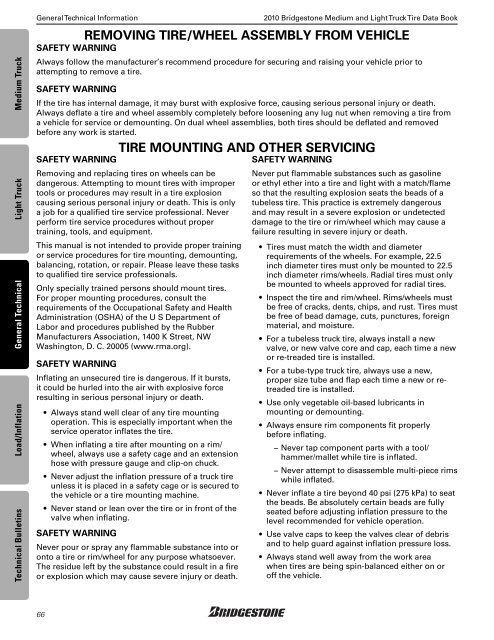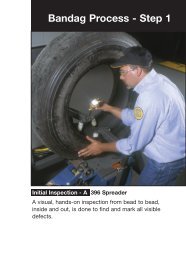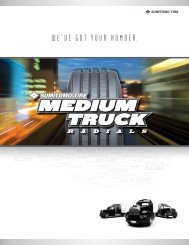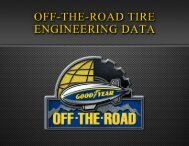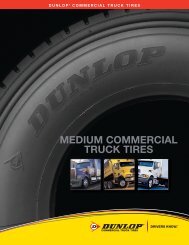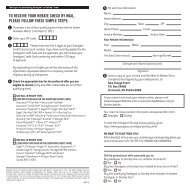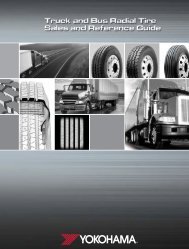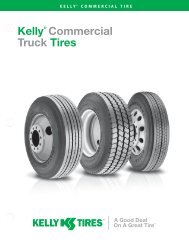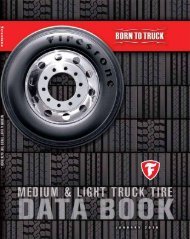Bridgestone Medium and Light Truck Tire Data Book - Sullivan Tire ...
Bridgestone Medium and Light Truck Tire Data Book - Sullivan Tire ...
Bridgestone Medium and Light Truck Tire Data Book - Sullivan Tire ...
Create successful ePaper yourself
Turn your PDF publications into a flip-book with our unique Google optimized e-Paper software.
Technical Bulletins Load/Inflation General Technical <strong>Light</strong> <strong>Truck</strong> <strong>Medium</strong> <strong>Truck</strong><br />
General Technical Information<br />
2010 <strong>Bridgestone</strong> <strong>Medium</strong> <strong>and</strong> <strong>Light</strong> <strong>Truck</strong> <strong>Tire</strong> <strong>Data</strong> <strong>Book</strong><br />
REMOVING TIRE/WHEEL ASSEMBLY FROM VEHICLE<br />
SAFETY WARNING<br />
Always follow the manufacturer’s recommend procedure for securing <strong>and</strong> raising your vehicle prior to<br />
attempting to remove a tire.<br />
SAFETY WARNING<br />
If the tire has internal damage, it may burst with explosive force, causing serious personal injury or death.<br />
Always deflate a tire <strong>and</strong> wheel assembly completely before loosening any lug nut when removing a tire from<br />
a vehicle for service or demounting. On dual wheel assemblies, both tires should be deflated <strong>and</strong> removed<br />
before any work is started.<br />
TIRE MOUNTING AND OTHER SERVICING<br />
SAFETY WARNING<br />
Removing <strong>and</strong> replacing tires on wheels can be<br />
dangerous. Attempting to mount tires with improper<br />
tools or procedures may result in a tire explosion<br />
causing serious personal injury or death. This is only<br />
a job for a qualified tire service professional. Never<br />
perform tire service procedures without proper<br />
training, tools, <strong>and</strong> equipment.<br />
This manual is not intended to provide proper training<br />
or service procedures for tire mounting, demounting,<br />
balancing, rotation, or repair. Please leave these tasks<br />
to qualified tire service professionals.<br />
Only specially trained persons should mount tires.<br />
For proper mounting procedures, consult the<br />
requirements of the Occupational Safety <strong>and</strong> Health<br />
Administration (OSHA) of the U S Department of<br />
Labor <strong>and</strong> procedures published by the Rubber<br />
Manufacturers Association, 1400 K Street, NW<br />
Washington, D. C. 20005 (www.rma.org).<br />
SAFETY WARNING<br />
Inflating an unsecured tire is dangerous. If it bursts,<br />
it could be hurled into the air with explosive force<br />
resulting in serious personal injury or death.<br />
• Always st<strong>and</strong> well clear of any tire mounting<br />
operation. This is especially important when the<br />
service operator inflates the tire.<br />
• When inflating a tire after mounting on a rim/<br />
wheel, always use a safety cage <strong>and</strong> an extension<br />
hose with pressure gauge <strong>and</strong> clip-on chuck.<br />
• Never adjust the inflation pressure of a truck tire<br />
unless it is placed in a safety cage or is secured to<br />
the vehicle or a tire mounting machine.<br />
• Never st<strong>and</strong> or lean over the tire or in front of the<br />
valve when inflating.<br />
SAFETY WARNING<br />
Never pour or spray any flammable substance into or<br />
onto a tire or rim/wheel for any purpose whatsoever.<br />
The residue left by the substance could result in a fire<br />
or explosion which may cause severe injury or death.<br />
SAFETY WARNING<br />
Never put flammable substances such as gasoline<br />
or ethyl ether into a tire <strong>and</strong> light with a match/flame<br />
so that the resulting explosion seats the beads of a<br />
tubeless tire. This practice is extremely dangerous<br />
<strong>and</strong> may result in a severe explosion or undetected<br />
damage to the tire or rim/wheel which may cause a<br />
failure resulting in severe injury or death.<br />
• <strong>Tire</strong>s must match the width <strong>and</strong> diameter<br />
requirements of the wheels. For example, 22.5<br />
inch diameter tires must only be mounted to 22.5<br />
inch diameter rims/wheels. Radial tires must only<br />
be mounted to wheels approved for radial tires.<br />
• Inspect the tire <strong>and</strong> rim/wheel. Rims/wheels must<br />
be free of cracks, dents, chips, <strong>and</strong> rust. <strong>Tire</strong>s must<br />
be free of bead damage, cuts, punctures, foreign<br />
material, <strong>and</strong> moisture.<br />
• For a tubeless truck tire, always install a new<br />
valve, or new valve core <strong>and</strong> cap, each time a new<br />
or re-treaded tire is installed.<br />
• For a tube-type truck tire, always use a new,<br />
proper size tube <strong>and</strong> flap each time a new or retreaded<br />
tire is installed.<br />
• Use only vegetable oil-based lubricants in<br />
mounting or demounting.<br />
• Always ensure rim components fit properly<br />
before inflating.<br />
− Never tap component parts with a tool/<br />
hammer/mallet while tire is inflated.<br />
− Never attempt to disassemble multi-piece rims<br />
while inflated.<br />
• Never inflate a tire beyond 40 psi (275 kPa) to seat<br />
the beads. Be absolutely certain beads are fully<br />
seated before adjusting inflation pressure to the<br />
level recommended for vehicle operation.<br />
• Use valve caps to keep the valves clear of debris<br />
<strong>and</strong> to help guard against inflation pressure loss.<br />
• Always st<strong>and</strong> well away from the work area<br />
when tires are being spin-balanced either on or<br />
off the vehicle.<br />
66


